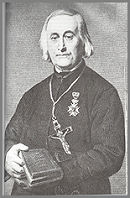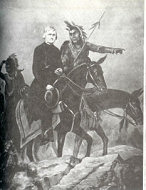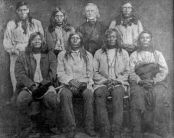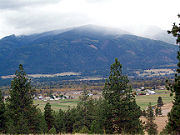
Fr. De Smet, S. J. 1801-1873
Pierre Jean De Smet was born in Termonde (Dendermonde), Belgium in 1801. He attended the Preparatory Seminary at Mechelen, Belgium in 1820. During this time, Fr. Charles Nerinckx visited seeking recruits for his mission in Kentucky. De Smet was fascinated with the prospect of ministering to the Indian tribes and joined the group of recruits.
Following his emigration to America he entered the Jesuit novitiate at Whitemarsh, Maryland in 1821 and took his vows for the priesthood at Florissant, Missouri in 1827.
In his lifetime, Fr. De Smet was responsible for the establishment of many missions in the far west and would travel over 180,000 miles (some estimates are as high as 260,000), making 19 trans-Atlantic crossings seeking missionaries and funds for those missions.
In 1849 Fr. De Smet was appointed Assistant Vice Provincial and Procurator of Missouri. Due to his rapport with the natives and the trust they placed in him, he was called upon several times to assist the Bureau of Indian Affairs and the U.S. Army in their peace negotiations with the Indians. Most notable of these was his meeting with Chief Sitting Bull and the resultant peace treaty agreed to by the Sioux tribe in 1868. He was also instrumental in establishing peace among warring tribes. His trips to Europe to seek funds for the missions continued until his health failed. Fr. De Smet died in St. Louis, Missouri on May 23, 1873.
Fr. De Smet on "Lizette"
with Indian escort
Courtesy Gonzaga University
Fr. De Smet's involvement with what was to become St. Mary's Mission began during the 1823-24 trapping season when several Iroquois trappers for the Hudson Bay Company remained among the Salish (Flathead) tribe. They were adopted into the tribe and married the Salish women.
The Iroquois, having been introduced to Christianity some two hundred years earlier, told stories about the white men who wore long robes and taught about God.
Between 1831 and 1839 the Salish and the neighboring Nez Perce sent four delegations to St. Louis to obtain a "black robe" to live among them and teach the things which the Iroquois had referred to. The last delegation, comprised of two Iroquois adopted into the Salish tribe was successful and the Indians were promised that a "black robe" would be sent to them.
March 27, 1840 Fr. De Smet set out from St. Louis on his maiden trip to the Rocky Mountains. His assignment, based on the Indian delegation's request for a priest, was to determine whether or not it was feasible to establish permanent missions in the remote areas of the American west.
It was decided that one member of the delegation (Lefthand Peter - Peter Gaucher) would travel ahead to relay the good news to the Salish people that a "black robe" was coming. A second member, Young Ignace, would wait at Westport, Missouri Territory (to become Kansas City) and accompany the missionary.
Peter Gaucher arrived at the Salish camp on Eight Mile Creek in the Bitterroot Valley at about the time Fr. De Smet was departing St. Louis. The news he imparted that a "black robe" was coming created joy and excitement among the tribal members. A detail of ten warriors was sent to meet the priest and provide an escort. The chief and remaining tribal members were to follow.
Fr. De Smet & Historic St. Mary's Mission
Having met up with Ignace in Westport, Fr. De Smet obtained supplies and horses and then joined a caravan of the American Fur Company. The party of about 40 members left Westport on April 30, 1840 - their destination was the American Fur Company rendezvous on Green River (Wyoming). Two months later, on June 30th, the travelers arrived at their destination. Fr. De Smet was surprised to find the ten warriors awaiting him to act as guides to the main Salish camp. On Sunday, July 5, Fr. De Smet celebrated Mass for the gathering of trappers, traders and Indians which became known as "The Prairie of the Mass".
A month later found the party at the headwaters of the Missouri (Three Forks, MT). It was here that Christianity was first preached in the State of Montana. Fr. De Smet baptized Chief Tjolzhitsay (Big Face) and Chief Walking Bear of the Pend d'Oreilles as well as some 350
tribal members.
The home of the Salish was still a long distance off, across the Divide in the Bitterroot Valley. Fr. De Smet decided that it would be best to return to St. Louis and get the necessary assistance to establish a permanent mission. His instruction to the Indians upon his departure was to seek out a fertile tract of land where they could settle.
The return journey took four months and on December 31st Fr. De Smet found himself once again in St. Louis at the University. Disappointment was keen when he learned that funds were lacking for a new expedition and establishment of a mission. Undaunted, De Smet undertook a fund raising campaign which took him to Philadelphia and New Orleans, among other places, seeking help. Within a few months he had raised the necessary amount. Upon gaining final approval, Fathers De Smet, Point, and Mengarini along with coadjutor brothers, Specht, Claessens and Huet and three laborers departed Westport May 10, 1841.
On September 24, 1841, after an arduous four month journey fraught with hunger, raging rivers, and treacherous trails, the party entered the valley chosen by the Salish to be their permanent home. The valley was named St. Mary's Valley (later changed to Bitterroot Valley) and De Smet described it as being, "from four to seven miles wide, and about two hundred long. It has but one defile, which serves as the entrance to and issue from the valley. The mountains which terminate it on both sides appear to be inaccessible." The tallest mountain to the west was named St. Mary's Peak.
Having established the base for a permanent mission, Fr. De Smet explored more of the territory and established additional missions. His trips to Europe continued in an effort to raise money for the missions and recruit missionaries. The respect afforded him by the natives led to his becoming a mediator for both the U.S. Government and the Native Americans. In 1846 he was recalled from active missionary work to serve as fund raiser and propagandist for the Native American missionary work as well as being a mediator. He continued in this role until his death in 1873.
Fr. De Smet (back row)
Chief Charlo (front row -left)
Source Unknown

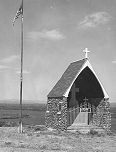
Monument at the site of
"The Prairie of the Mass"
Green River, Wyoming
Following several days at the Green River Rendezvous, Fr. De Smet and his escort left to join the main camp of Salish and Pend d' Oreills at Pierre's Hole a valley below and west of the Tetons. At the end of this eight day journey Fr. De Smet was greeted by an estimated 1,600 tribal members, some of whom had traveled over 800 miles to meet the "black robe". He was lead to the lodge of the great chief, Tjolzhitsay (whom Fr. De Smet called Big Face), and received the warmest of welcomes. After a brief stay at Pierre's Hole, the entire gathering began moving towards the country of the Salish.
Pierre's Hole - near the Teton Mountains in Wyoming
Visit The Book Shop for more history of Fr. De Smet and his travels.
St. Mary's Peak in the
Bitterroot Valley
406-777-5734
Email: stmary@cybernet1.com
www.saintmarysmission.org


Last Update: 8/24/2016
Historic St. Mary's Mission, Inc. * All Rights Reserved
Web Site Design by S&J Enterprises
P.O. Box 211
315 Charlo Street
Stevensville, MT 59870
